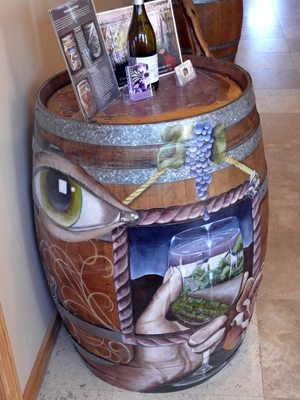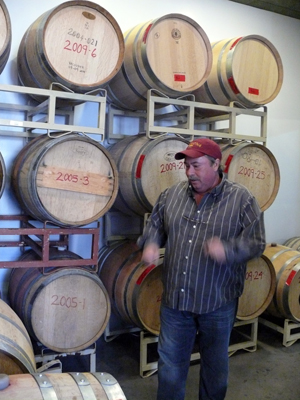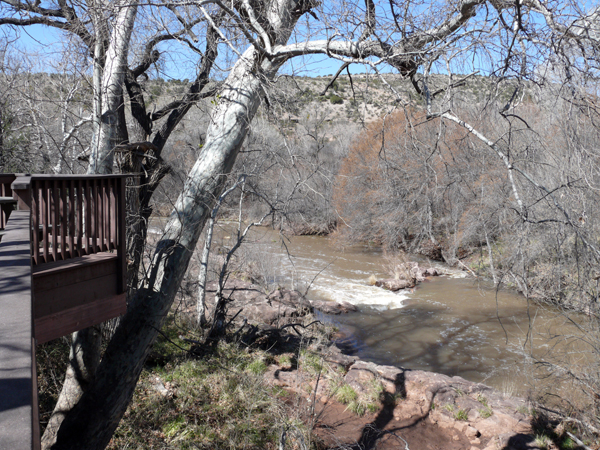SCOTTSDALE, ARIZONA – Sedona … Sonoma? Why is it I always get those two like-sounding city names mixed up, I ask to the man pouring me a glass of wine at a trendy Scottsdale restaurant called FnB?
The only way I tell them apart is by remembering that Arizona’s Sedona is where nature has carved giant likenesses of courthouses, cathedrals and castles into the soft red rock that dominates the surrounding landscape. California’s Sonoma, on the other hand, is where they make wine.
“We make wine in Sedona, too,” claims Pavle Milic, co-owner of the Old Town Scottsdale dining spot who is doubling as a server on this March evening.
You mean Sonoma?
“No, Sedona!” exclaims Milic, who says his restaurant serves “only” Arizona produced wines.
“The wine you’re drinking now is from the Sedona area,” says the restaurateur.
Now I’m really confused because Sedona, like most of Arizona, is desert – not exactly ideal growing conditions for grapes.
Wrong, says my host. The high desert ranges where most of Arizona’s wineries are located feature hot days and cool nights – “that’s perfect growing conditions for grapes,” he claims. The elevations of those ranges – between 1,000 and 3,000 metres – are similar to Mendoza, Argentina, where the best of that South American wine giant’s products are produced.
As Milic finishes pouring me a glass of the grape made at the Arizona Stronghold Vineyards - an operation located just outside Sedona in the small town of Cottonwood – he tells me, “there are more than a dozen boutique wineries in the Sedona area and more are coming on line every year.”
Stronghold’s 2009 Roan Red, a Rhone-style blend, is soft to the scent – I pick up hints of cherry, cinnamon and nutmeg. It’s a very pleasant introduction to Arizona wine.


Above: The wine barrels and the wine makers are unique.
My host then uncorks a 2009 Sauvignon Blanc produced by the Javelina Leap Winery – a vineyard named after a small black wild pig that roams the desert. The young vintage is refreshingly light and features pear, peach and mild citrus flavours.
As we begin to sample Javelina’s 2009 Cab-Sav – not as good as the vineyard’s Sauvignon Blanc, I must report – Milic tells me Arizona’s red clay soil is nearly identical to that found in Burgundy, France and that many of the state’s wines display a distinct French boldness, highlighted by flavours ranging from earth tones and spices with floral notes and chocolate – much like their Burgundy counterparts.
And, he says, wine making is not new to Arizona. Spanish missionaries began planting vines back in the 16th century for wine that was used in religious ceremonies. The first modern day winery appeared in 1973 and now the state has 39 licensed vineyards with more and more appearing every year.
But how good are Arizona wines?
Well, Milic says he held a blind taste testing in his restaurant in 2010 and Arizona wines won both the white (a Callaghan 2008) and red (a Caduceus 2008) category, beating out Italian, California, Spanish and French competitors along the way.
Arizona wines have even been served at White House diplomatic parties.
Most of the state’s vineyards are located in the south-eastern part of the state around Tucson and they’re usually started by professionals as a hobby – one winery is owned by a Hollywood movie producer and another a rock star but Milic refuses to reveal their names.
One of the big benefactors of Arizona’s wine industry is the state’s tourism sector. Word spread quickly about the quality of Arizona’s vintages and a tourist “wine trail” suddenly started up.
“The wine trail around Sedona is really quite lovely and the growers in that region are great people,” says Milic, who encourages me to take the Carefree Highway – the legendary road that connects Sedona with Scottsdale that was made famous in Gordon Lightfoot’s 1967 hit song of the same name – to see for myself.
Next day, I head north humming “Carefree Highway” as I pass forests of Saguaro cactus – the state’s official symbol – and native lands where some of Arizona’s 22 Indian tribes still live, until I reach Sedona.
The burgundy-coloured rock formations that ring the artist town where holistic healers and hippies have been hanging out for decades, remind me it’s time to sample some of the state’s highly-touted rose vintages – Stronghold’s Dayden 2008 was my favourite.
A gravel road just outside Sedona leads me to the entrance of the Javelina Leap vineyard in Willcox where a stocky man named Rod Snapp welcomes me to the winery he opened 12 years ago.
“Owning a vineyard was always a life-long dream of mine,” the ex-fireman tells me. “I poured everything I had into financing this place and now I’m living the dream – making wine and making some money.”
While Arizona’s wine is good, the state’s vintners are even better. The congenial Snapp, who welcomes about 20,000 tourists each year to his vineyard, is proof of that.
Javelina Leap is a boutique operation spread over 21 rocky acres of desert land that produces 3,000 cases a year which, according to Snapp, are snapped up quickly by locals, tourists and “fan club” members.
Snapp and other Sedona wine growers rely heavily on the area’s natural springs to irrigate their vines and much of the terrain in these parts is being transformed into lush vineyards.
“It took me five years to produce my first bottle of wine and to be truthful, the first bottle wasn’t very good,” whispers Snapp, who quickly adds, “but it’s been much better ever since.”
Next stop on my Sedona wine tour: Page Spring Cellars – just down the road from Javelina Leap. Page Springs is crowded with visitors, all sampling the Rhone-style wine the vineyard is noted for producing. A lovely stream that cuts through the property and the blue sky canopy that hangs over the vineyard about 300 days of the year makes the whole alfresco wine tasting experience at Page Springs an intoxicating experience. I’m then directed to the small town of Cottonwood, where several Arizona wineries, including Stronghold Vineyards have set up shop.

Above: Rural Arizona has become one of America's best wine regions.
Cottonwood is a throw-back to the state’s Wild West era. Its main street is crammed with antique shops, wine stores and olive oil shops – Arizonians love imported olive oil as much as their wine – and locals tell me the town was “bootleg heaven” during the time of U.S. Prohibition.
“They’ve uncovered lots of tunnels running under Old Town Cottonwood where bootlegged whiskey was stored during the 1920s,” says Stephanie, the charming hostess at the Pillsbury Wine Company tasting room located on Main Street.
“But the whiskey was really meant for the folks living in Jerome, not Cottonwood,” says Stephanie. (Jerome’s a neighbouring mining community known as the enfant terrible of Arizona towns in its “Roaring 20s” heyday when 45,000 roughneck miners lived there – the population has since shrunk to about 500.)
The Pillsbury wines have achieved some notable acclaim from such publications as the San Francisco Examiner which called it “the best wine in Arizona”; Wine Spectator said Pillsbury is the “rising star of the west”; and noted wine critic Mark Tarbell rated it a “93” on his 100-point scale. It tasted pretty good to me!
Across the street, the young man serving up samples of the Stronghold Vineyards’ best tells me “wine is becoming as important an industry in Arizona as tourism.”
The handcrafted wine made by Stronghold is named after Apache warriors and the 2009 Stronghold Mangus, a super Tuscan blend, can hold its own against all comers. A Rhone blend called Nachise is another wine Stronghold can be proud to put its label on – the vineyard’s label, a blazing sun, is one of the best we’ve ever seen.
Stronghold’s reds hit the nose with hints of cherry fruit and cinnamon and the palate packs more bright fruit and tangy acid – a lovely combination, as one wine critic noted, of New World softness with Old World bite.
The only thing we didn’t like was the price of Arizona wines – limited production at these boutique wineries, combined with high local demand, means bottles of young wines are being sold at old wine prices. As production picks up, the prices are sure to drop.
So now I know grapes can grow in the desert – Arizona’s excellent wine industry is proof of that.